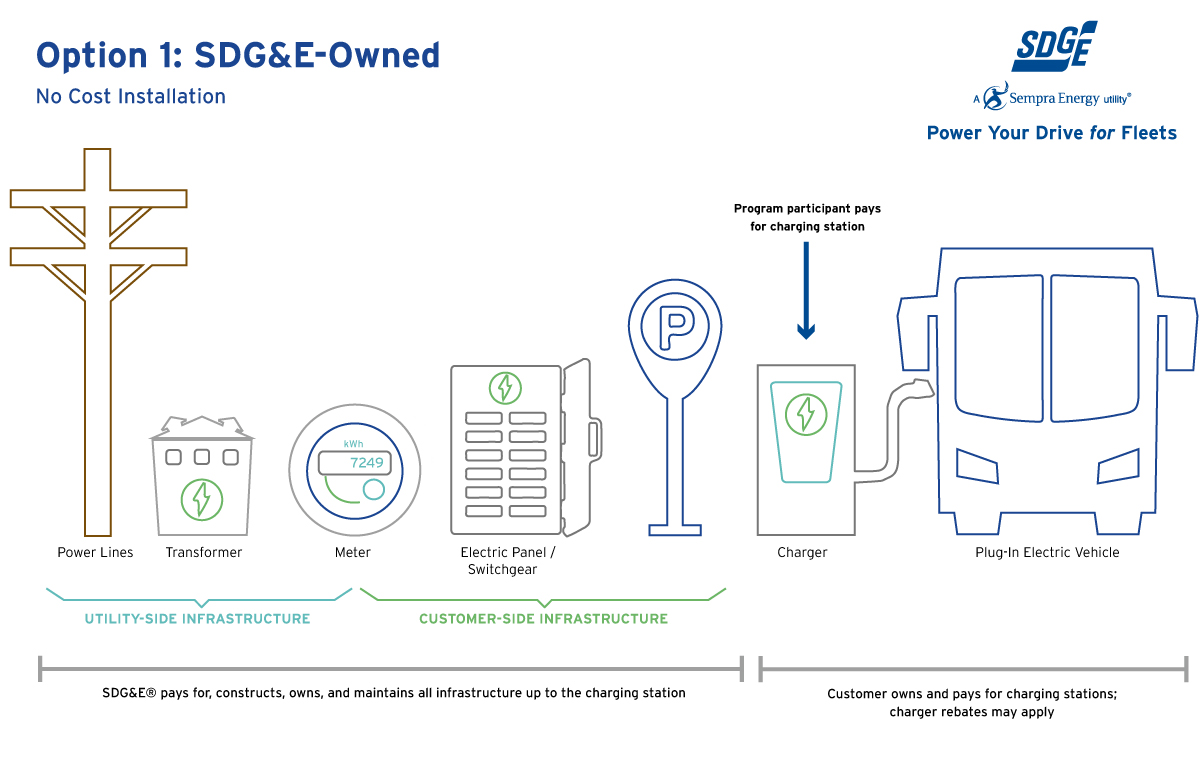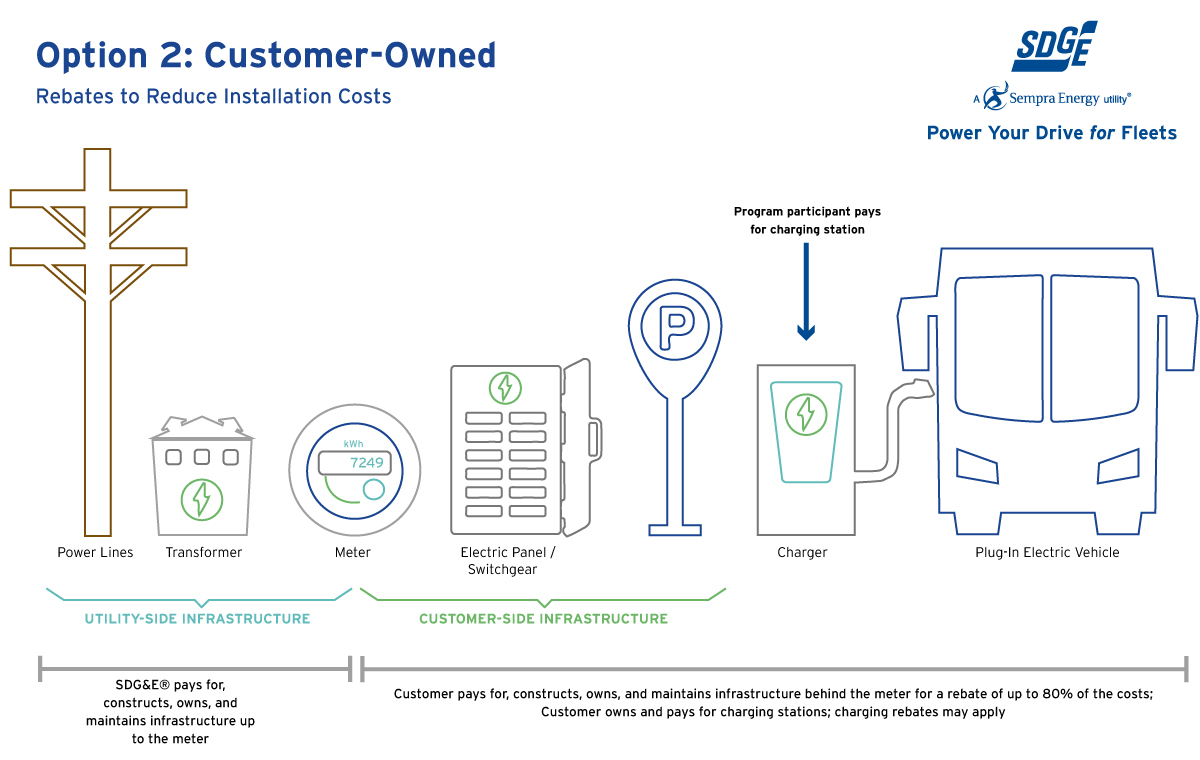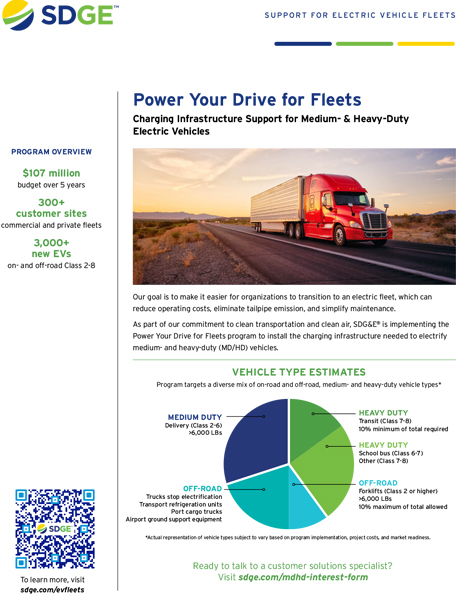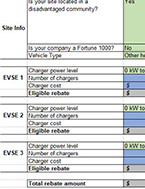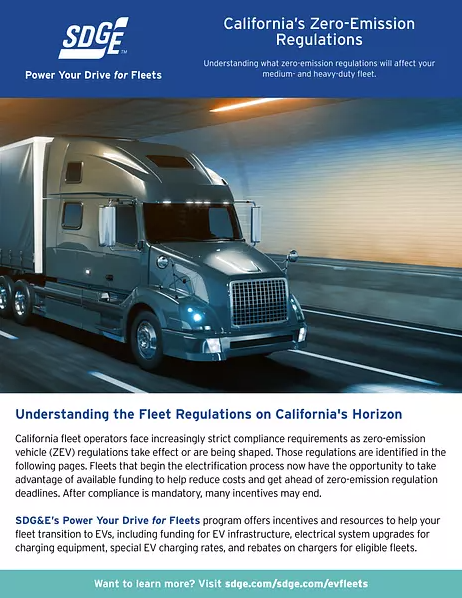Power Your Drive for Fleets
Power Your Drive for Fleets helps fleet owners and operators reduce operating costs, eliminate emissions, and simplify vehicle maintenance by transitioning to electric vehicles.
The program connects fleets with resources, fleet-friendly charging rates, and financial incentives to easily and cost-effectively design and install the charging infrastructure needed to power medium- and heavy-duty electric fleets.
Want more information?
Sign up to stay up to date on the latest program news, webinars, resources, and more.
Ready to apply?
Find out if you are eligible and connect with a member of our team who can help you begin the application process.
Have you heard of VGI?
Discover how to use your EV to optimize energy usage, reduce costs, and support a sustainable future.
Electrification Timeline
SDG&E works with fleets from the initial infrastructure planning stage through to design, construction, and ongoing site maintenance.
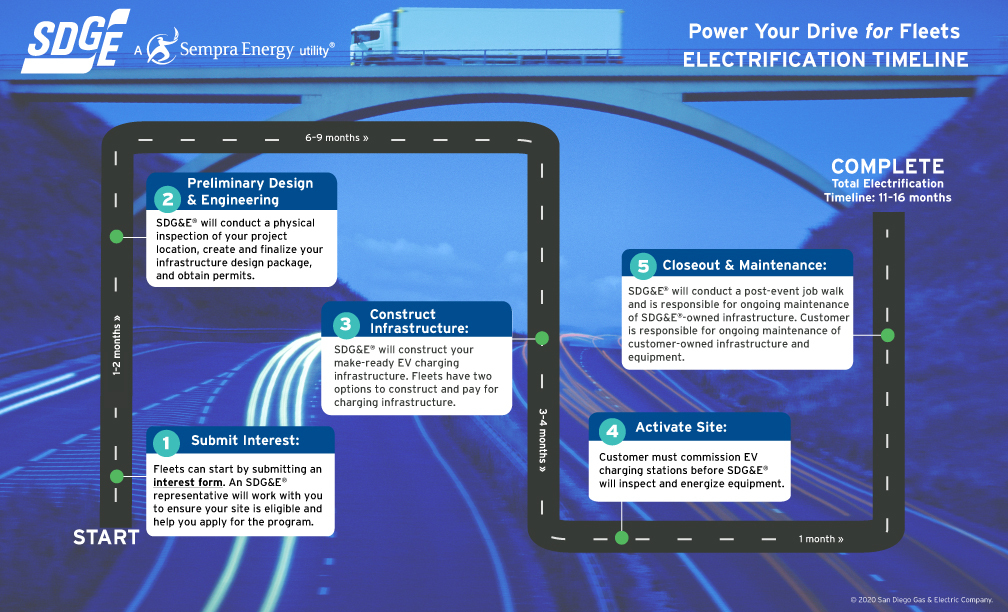
Download Electrification Timeline PDF
Step 1 - Submit Interest (1-2 months): Fleets can start by submitting an Interest Form. An SDG&E representative will work with you to ensure your site is eligible and help you apply for the program.
Step 2 - Preliminary Design & Engineering (6-9 months)-: SDG&E will conduct a physical inspection of your project location, create and finalize your infrastructure design package, and obtain permits.
Step 3 - Construct Infrastructure (3-4 months): SDG&E will construct your make-ready EV charging infrastructure. Fleets have two options to construct and pay for charging infrastructure. Learn more about Infrastructure Installation Options.
Step 4 - Activate Site (1 month): Customer must commission EV charging stations before SDG&E will inspect and energize equipment.
Step 5 - Closeout & Maintenance: SDG&E will conduct a post-event job walk and is responsible for ongoing maintenance of SDG&E-owned infrastructure. Customer is responsible for ongoing maintenance of customer-owned infrastructure and equipment.
Option 1: SDG&E Owned, No Cost Installation
- SDG&E pays for, constructs, owns, and maintains all infrastructure up to the charging station.
- Customer pays for, constructs, owns, and maintains charging stations.
Option 2: Customer Owned, Rebates to Reduce Installation Costs:
- SDG&E pays for, constructs, owns, and maintains all infrastructure up to the meter.
- Customer pays for, constructs, owns, and maintains “customer-side infrastructure” and charging stations.
- SDG&E provides a rebate of up to 80% of the cost of “customer-side infrastructure” is available.
See Infrastructure Installation Options for more details.
Fleet Friendly Charging Rates
For businesses currently charging a fleet of electric vehicles, SDG&E offers the EV-HP rate, to eliminate demand charges and simplify billing.
The EV-HP Rate plan is a new rate structure that allows EV fleet customers to choose the amount of power they need to charge their vehicles and pay for it with a simple, predictable monthly subscription fee. Download the EV-HP Fact Sheet to learn more.
Additional Charger Rebates
Transit agencies, school districts, and fleets located in disadvantaged communities that are not Fortune 1000 companies are eligible for an additional rebate of up to 50% of the costs to purchase charging stations.
Maximum Rebate Amounts Available
| EVSE power | Max. rebate amount* |
|---|---|
|
Up to 19.2 kW |
$3,000 per charger |
|
19.3 kW up to 50 kW |
$15,000 per charger |
|
50.1 kW up to 150 kW |
$45,000 per charger |
| 150.1 kW and above | $75,000 per charger |
*Eligible sites will receive a rebate for each qualified charger for the lesser of 50% of the cost of the charger or the maximum amount based on power output as detailed above, not to exceed 50% of the cost of the charger
Additional Funding
To help buy-down the cost of purchasing electric vehicles and infrastructure, several state funding programs can be combined with funding available through Power Your Drive for Fleets.
See our Program Funding Summary to learn more.
Want more information?
Sign up to stay up to date on the latest program news, webinars, resources, and more.
Ready to apply?
Find out if you are eligible and connect with a member of our team who can help you begin the application process.
Want more information?
Sign up to stay up to date on the latest program news, webinars, resources, and more.
Ready to apply?
Find out if you are eligible and connect with a member of our team who can help you begin the application process.
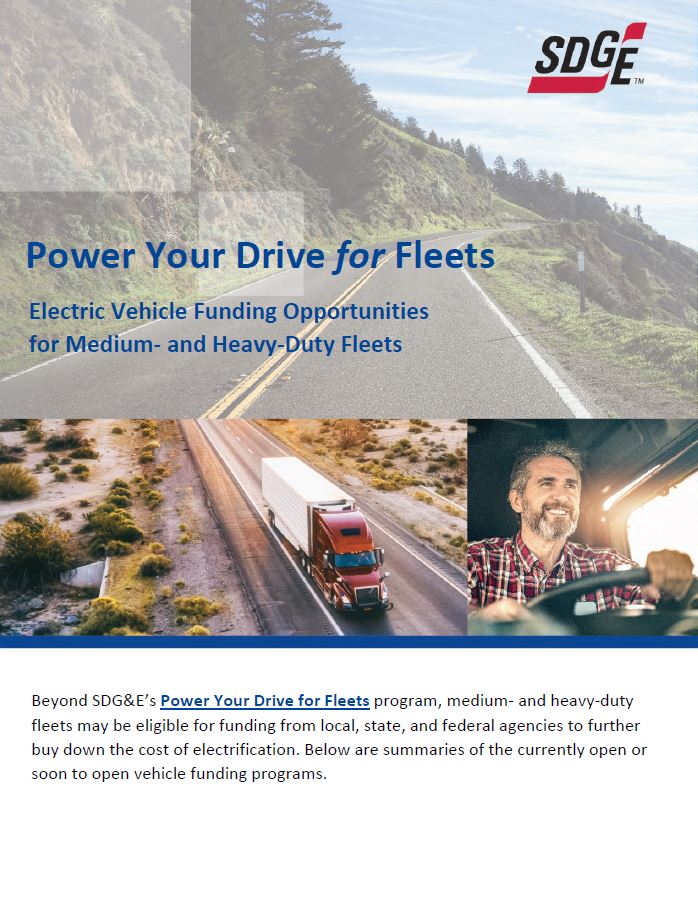
EV Incentives
Fact Sheet Summary
EPRI Vetted Product List
The Electric Power Research Institute (EPRI) manages a vetted product list evaluated against criteria developed by industry consensus, utility input, and review of government agency requirements for electric vehicle supply industry equipment. SDG&E’s Power Your Drive for Fleets program utilizes this list for all approved equipment for the program. Please visit EPRI’s Vetted Product List page for a comprehensive resource of products or to apply for product review to have your equipment added to the list.

Frequently Asked Questions
MD/HD EV Charging Infrastructure Program Information
As approved by the California Public Utilities Commission (CPUC) in Aug 2019, the MD/HD EV Charging Infrastructure program includes the following key elements:
- A minimum of 300 make read installations fully contracted for after five years of program deployment and 3,000 additional vehicles electrified
- A minimum of 10 percent of the infrastructure budget to serve transit and school buses
- A maximum of 10 percent of the infrastructure budget to serve forklifts
- A minimum of 30 percent of the infrastructure budget to serve disadvantaged communities
- Charging station rebate levels (not to exceed 50 percent of the charger cost) for customers in beach head sectors and customers in disadvantaged communities, in consultation with SDG&E’s Program Advisory Council
- A maximum of 10 percent of the infrastructure to be spent on program administration.
- Beachhead sectors are a defined term for purposes of this program – applies to transit buses and school buses.
- If an entity is in a DAC but is also a Fortune 1000 company they do NOT get the EVSE rebate.
There are two ownership structures in the MD/HD EV Charging Infrastructure program:
Option 1:
- Customer designs, builds, owns, operates, and maintains Behind-The-Meter (BTM) make-ready infrastructure.
- In this case, SDG&E will construct, own, and maintain all To-The-Meter (TTM) costs and provide a rebate for up to 80% of BTM costs.
Option 2:
SDG&E designs, builds, owns, operates, pays for, and maintains all infrastructure up to the charger.
- Behind the meter (BTM) infrastructure work for MD/HD EV Charging Infrastructure program includes everything from the meter up to the charger stub (excluding the charger) – BTM switchgear, any stepdown transformers (if needed), concrete pads for the equipment, trenching and installing of conduits and wires to the charger stubs.
- To the meter (TTM) infrastructure work for MD/HD EV Charging Infrastructure program includes everything upstream of the meter - stepdown transformers, circuit protection equipment, concrete pads for the equipment, trenching and installing of conduits and wires to the switchgear.
- Amount to be determined by Program Advisory Council (PAC). This also excludes the cost of the charger.
Yes, several state rebate programs are fully stackable with the MD/HD EV Charging Infrastructure program . We are closely coordinating with major grant fund sources including the California Air Resources Board, California Energy Commission, and Air Quality Management District to help you best co-fund your project.
You could still participate in the program, however, the land owner will be required to execute a land rights document (easement).
Gross Vehicle Weight Rating (GVWR) determines the vehicle class:
2 - 6,001 – 10,000 lbs
3 - 10,001 – 14,000 lbs
4 - 14,001 – 16,000 lbs
5 - 16,001 – 19,500 lbs
6 - 19,501 – 26,000 lbs
7 - 26,001 – 33,000 lbs
8 - > 33,001 lbs
No, LCSF credits will be managed by the owner of the charging stations.
Yes. The charging stations will be served on a separate and dedicated meter.
Program Participants will own the charging stations and be responsible for any usage and maintenance costs.
The Program Participant is responsible for paying for all ownership, operation and maintenance costs associated with the charging equipment, including the cost of energy consumed by the charging equipment. All charging equipment will be required to take service on a Time-Of-Use rate plan. As owners and operators of the charging stations, Program Participants have discretion to determine their own charging periods and policies, but encouraging super off-peak or off-peak charging and discouraging on-peak charging will help lower monthly energy costs. SDG&E encourages participants to work with their SDG&E Clean Transportation Customer Solutions team member for assistance selecting the best rate plan options.
Program participants are required to select their charging station vendor from SDG&E's list of approved vendors upon availablity.
Participation
The program supports on road and off road medum and heavy duty vehicles including, but not limited to: light heavy duty trucks, medium duty trucks, heavy duty trucks, transit buses, commuter buses, school buses, airport ground support equipment (GSE).
- Complete an interest form to indicate your interest in participating in the program
- A SDG&E EV Customer Solutions team member will reach out to you to discuss program eligibility, process and timeline, and discuss next steps.
- Complete a program application to be considered for program participation (TBD).
As per the CPUC Decision requirement, SDG&E requires a Purchase Order for a minimum of two medium-or heavy-duty electric vehicles. However, having a bigger site would be advantageous from program cost and vehicle target perspective hence we would prefer bigger sites where possible. There is no maximum.
The term of the agreement is 10 years as the program requires all customers to operate and maintain the EVSE equipment for a period of 10 years.
The 10-year commitment is a requirement in the CPUC decision and therefore not something we are likely to be able to modify. SDG&E can provide customers with information about pro-rating their responsibility for the funding they receive in the event that they release the site or infrastructure prior to the 10-year term.
SDG&E will collect daily utilization data from the chargers in the form of 15 min intervals in additional to basic site level information. Collection of this data is a requirement set by the CPUC and will be reported to the CPUC annually.
SDG&E offers the EV-HP Rate to businesses charging a fleet of electric vehicles. The EV-HP rate simplifies billing, eliminates demand charges and allows EV fleet customers to choose the amount of power they need to charge their vehicles and pay for it with a simple, predictable monthly subscription fee.
Visit sdge.com/EV-HP to learn more.
Project Planning
This will need to be determined before the customer signs the program contract, which formally accepts the customer into the program with detailed project scope. The project scope will be based on preliminary desktop review, site walk findings, preliminary design and project cost estimate which will reflect either the SDG&E-owned or customer-owned make-ready infrastructure approach.
When deciding where to install the EV charging stations, many factors need to be considered, some of which should include:
- Select a location in close proximity to the electric facilities currently serving the site (this can help to lower infrastructure installation costs);
- Determine a convenient location for vehicle parking while they will be charging (for both short and long dwell times); Consider how vehicles move through the site, and how to prevent the charging location from impeding through-traffic;
- Consider locations where adequate parking exists to serve the number of vehicles that will be routinely charged;
- Consider any labor restrictions that may prevent drivers from backing up vehicles, will a drive-through type configuration be required;
- Consider vehicle charging needs beyond the initial deployment, what future growth and expansion might be taken into account;
- Consider the type of charging equipment that will be used, the charging port to vehicle ratios, and desired parking configurations surrounding the charging stations. Will they be laid out in a radial fashion, be laid-out in rows, or other configurations;
- Consider the configuration of charging stations themselves. Will they be overhead systems, conventional pedestal mounted; wall mounted; in-ground; etc.;
- For DCFC installations, consider proximity of charging ports to the Power Conversion Units (PCU). These are just some of the many factors that will need to be considered. SDG&E recommends that you contact your SDG&E Account Representative to explore solutions that will work best for your site’s needs.
It is important that interested customers involve all necessary stakeholders throughout the process so fleet electrification infrastructure is planned for and executed in a timely manner. Sustainability leads, finance leads, transportation or fleet operation leads and senior executives within a customer’s organization are all key stakeholders that should weigh in on the purchase of electric vehicles and associated spend on charging infrastructure. Conversations with those decision makers early in the process would be helpful for timely implementation of key decisions as pertaining to program participation.
Vendors and Contractors
In the case that the customer elects to construct their own make-ready infrastructure for the behind-the-meter portion to the charger stub, the customer must hire a qualified state-licensed labor and the design and construction must comply with all local, state, and federal electrical standards in order to be eligible for the program's make-ready infrastructure incentive. In the case that SDG&E constructs the entire make-ready infrastructure, the work will be executed by the design and construction contractors qualified by SDG&E.
It is imperative that you choose an EVSE provider that is compatible with the vehicle you select. You must first select your vehicle and then choose your EVSE provider.
